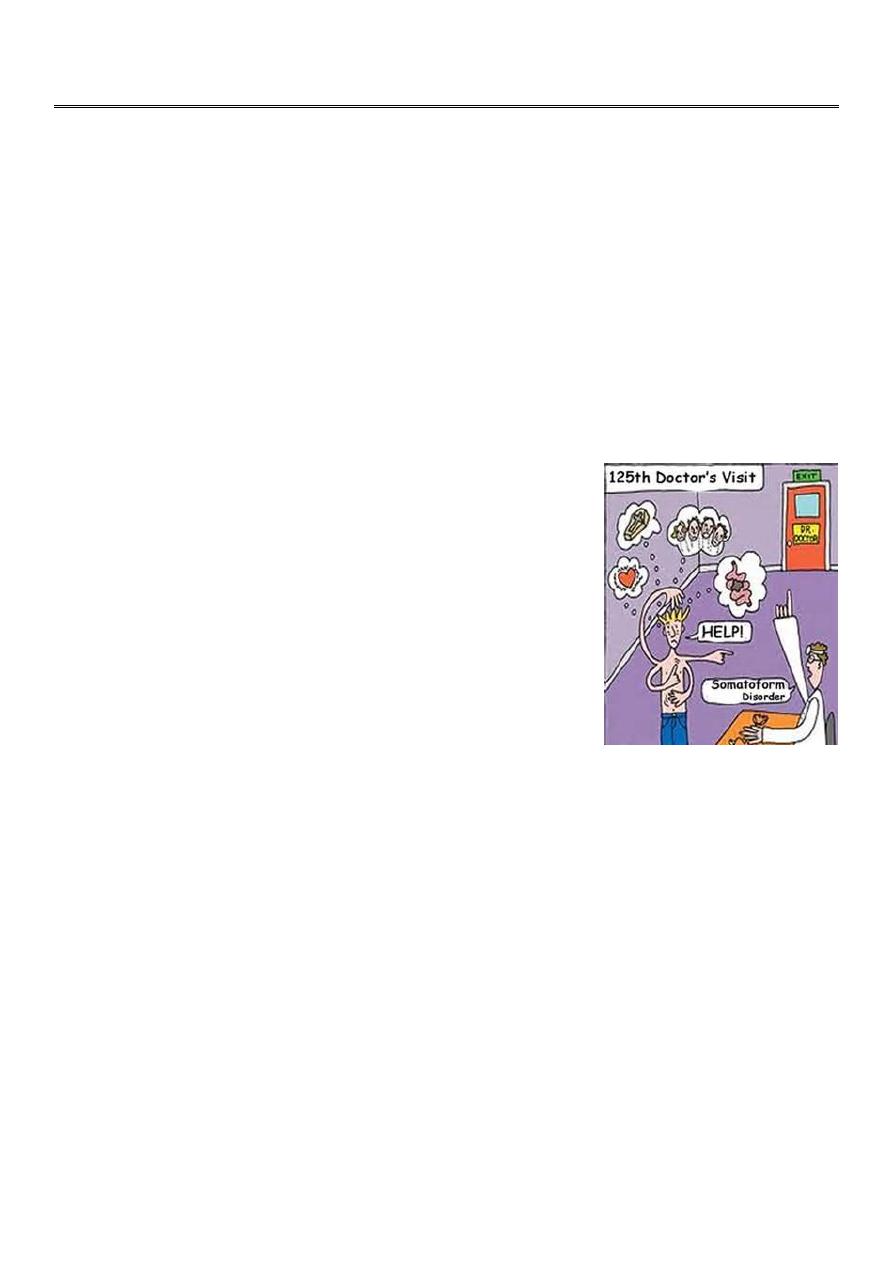
1
Fifth stage
Psychiatry
Lec-8
.د
الهام
13/11/2016
Somatization
disorder
Is a disorder in which there is repeated presentation with medically unexplained
symptoms, affecting multiple organ systems, first presenting before the age of 40.
It is usually chronic in adult.
In children, it usually involves one or a few organ systems, often for a shorter periods
of time.
At all ages, it is associated with significant psychological distress, functional
impairment, and risk of iatrogenic harm.
Full-blown somatization disorder or “Briquet’s syndrome” probably represents the
severe end of a continuum of abnormal illness behaviour.
Clinical features:
Somatization disorder patients have long , complex,
medical histories ( ‘fat-file’ patients).
Symptoms might occur in any system and are to some
extend suggestable.
The most frequent symptoms are non-specific and
atypical.
There may be discrepancy between the subjective and
objective finding (e.g. reports of intractable pain in in a
patient observed by nursing staff to be joking with relatives).
Symptoms are usually concentrated in one system at a time but may move to another
system after exhausting diagnostic possibilities in previous one.
The patient’s life revolves around the illness as does their family life.
There is excessive use of both medical services and alternative therapies.
Diagnosis is usually only suspected after negative findings begin to emerge as normal
medical practice is to take complaints at face value.
Key diagnostic feature is multiple, atypical, and inconsistent medically unexplained
symptoms in a patient under the age of 40.
Chronic cases will have had large numbers of diagnostic procedures and surgical or
medical treatments.
High risk of iatrogenic harm and iatrogenic substance dependence.
Hostility and frustration can be felt on both sides of the doctor-patient relationship
with splitting between members of treating team

2
Two-thirds of patients will meet criteria for another psychiatric disorder, most
commonly major depressive or anxiety disorders.
There is also association with personality disorder and substance abuse.
They characteristically deny emotional symptoms or attribute them directly to physical
handicaps ----’the only reason I'm depressed is this constant pain’.
Aetiology:
Observable clinical association with childhood illnesses in the patient and a history of
parental anxiety towards illness.
Increased frequency of somatisation disorder in first degree relatives.
Possible neuropsychiatric basis to the disorder with faulty assessment of normal
somatic sensory input.
Association with childhood sexual abuse.
Epidemiology:
Lifetime prevalence of 0.2%.
Markedly higher rate in particular populations. Female : male ratio 5:1.
Age of onset is childhood to early 30s.
Differential diagnosis:
Undiagnosed physical disorder: particularly those with variable, multi-system
presentations (e.g. SLE, AIDS, porphyria, tuberculosis, multiple sclerosis). Onset of
multiple symptoms for the first time in patients over 40 should be presumed to be due
to unexposed physical disease.
Psychiatric disorder: major affective and psychotic illnesses may initially present with
predominately somatic complaints. Diagnosis is by examination of other
psychopathology, however over half of somatization disorder patients exhibit
psychiatric comorbidity.
Other somatoform disorders: distinguish from: hypochondriasis (presence of firm belief
in particular disorder), somatoform pain disorder (pain rather than other symptoms is
prominent), conversion disorder (functional neurological loss without multi-system
complaints), factitious disorder (intentional production or feigning of physical
symptoms to assume sick role), and malingering (intentional production of false or
grossly exaggerated physical symptoms with external motivation) In practice the main
distinction is between the full and severe somatization disorder and somatization as a
symptom of other disorders.

3
Assessment:
Establish reasons for referral,
experience of illness,
attitudes to symptoms,
personal and psychiatric history,
family perspective.
Initial management:
Make, document, and communicate the diagnosis.
Acknowledge symptom severity and experience of distress as real but emphasize
negative investigations and lack of structural abnormality.
Reassure patient of continuing care.
Attempt to reframe symptoms as emotional.
Assess for and treat psychiatric comorbidity as appropriate.
Reduce and stop unnecessary drugs.
Consider case conference involving GP and treating physicians.
Educate patients/family.
On-going management:
Regular review by single, named doctor.
Reviews should be at planned and agreed frequency, avoiding emergency
consultations.
Symptoms should be examined and explored with a view to their emotional’ meaning’.
Avoid tests ‘to rule out disease’, investigate objective signs only.
All secondary referrals made through one individual.
Disseminate management plan.
These patients can exhaust a doctor's resources ----plan to share the burden over time.
Some evidence for the effectiveness of patient education in symptom re-attribution, brief
contact psychotherapy, group therapy, or CBT if the patient can be engaged in this.
Prognosis:
Poor in the full disorder;
tendency is for chronic morbidity with periods of relative remission.
Treatment of psychiatric comorbidity and reduction of iatrogenic harm will reduce
overall morbidity.

4
Key for recovery in children and adolescents is rehabilitation and return to usual
activities as soon as possible.
Somatoform pain disorder:
In somatoform pain disorder there is a complaint of persistent severe and distressing
pain which is not explained or not adequately explained by organic pathology.
The causation of the symptom is attributed to psychological factors.
This disorder is diagnosed where the disorder is not better explained by somatization
disorder, another psychiatric diagnosis, or psychological factors in general medical
condition.
All pain is a subjective sensation and its severity and quality as experienced in an
individual is dependent on a complex mix of factors including:
o the situation,
o the degree of arousal,
o the affective state,
o the beliefs about the source,
o and meaning of the pain.
The experience of pain is modified by its chronicity and associations and there is a
‘two-way’relationship with affective state, with chronic pain predisposing to depressive
illness, while depressive illness tends to worsen the subjective experience of pain.
Comorbidity:
In common with the other somatoform disorders there is substantial overlap with
major depression (-40% in pain clinic patients) and anxiety disorders.
Substance abuse (including iatrogenic opiate dependency) and personality disorder
patients are over-represented.
Epidemiology:
No population data are available.
The prevalence of patients with medically unexplained pain varies by clinical setting;
higher in inpatient settings, particularly surgery, and highest in pain clinic patients.
Differential diagnosis:
Elaboration of organic pain
Malingering ( e.g. patient with opiate dependency seeking opiate prescription)
Genuine organic cause with absence of other manifestations (e.g.sickle cell crisis,
angina).

5
Assessment:
History from patient and informants,
length of history (may be minimized),
relationship to life events,
general somatization,
experience of illness,
family attitude to illness,
periods of employment,
treatments,
beliefs about cause,
comorbid psychiatric symptoms.
comorbid psychiatric symptoms.
Management:
It is important to recognize and treat occult comorbid depression.
It is often helpful to adopt an a theoretical approach: ‘let's see what works’, and to
resist pressure for ‘all or nothing’ cure or a move to investigation by another specialty.
Opiates not generally effective in chronic pain of this type and add the risk of
dependence.
Psychological treatments: these are directed towards enabling the patient to manage
and ‘live with’ the pain, rather than aspiring to eliminate it completely; can include
relaxation training, biofeedback, hypnosis, group work, CBT.
Pain clinics: these are generally anaesthetist-led with variable psychiatric provision.
They offer a range of physical treatments such as: antidepressants, transcutaneous
electrical nerve stimulation (TENS), anti-convulsants, and local or regional nerve-blocks.
